
Kurma, is the second avatar of the Hindu preserver deity, Vishnu. Originating in Vedic literature such as the Yajurveda as being synonymous with the Saptarishi called Kashyapa, Kurma is most commonly associated in post-Vedic literature such as the Puranas. He prominently appears in the legend of the churning of the Ocean of Milk, referred to as the Samudra Manthana. Along with being synonymous with Akupara, the World-Turtle supporting the Earth, Kurma is listed as the second of the Dashavatara, which are the ten principal incarnations of Vishnu.
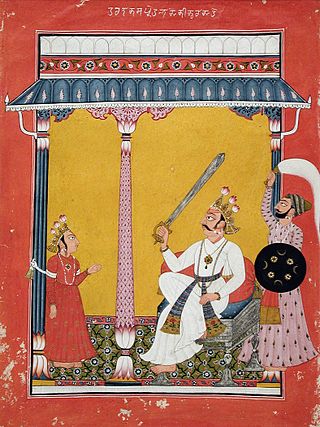
Hiranyakashipu, also known as Hiranyakashyap, was a daitya king of the asuras in the Puranas.

Vamana also known as Trivikrama, Urukrama, Upendra, Dadhivamana, and Balibandhana, is an avatar of the Hindu deity Vishnu. He is the fifth avatar of Vishnu and the first Dashavatara in the Treta Yuga, after Narasimha.

In Hindu scriptures, Durvasa, also known as Durvasas, is a legendary rishi (sage). He is the son of Anasuya and Atri. According to some Puranas, Durvasa is a partial avatar of Shiva, known for his short temper. Wherever he goes, he is received with great reverence by humans and devas alike.

Kamakhya, a mother goddess, is a Shakta Tantric deity; considered to be the embodiment of Kama (desire), she is regarded as the goddess of desire. Her abode–Kamakhya Temple is located in the Kamarupa region of Assam, India. Originally a Kirata goddess, Residing on Nilachal hills across the banks of the Brahmaputra River, west of Guwahati in the 10th/11th century Temple rebuilt in 1565 CE, she is worshiped in a non-iconic and un-anthropomorphic form of stone shaped like yoni fed by a perennial stream. The temple is primary amongst the 51 Shakti Pithas, and is one of the most important Shakta temples.
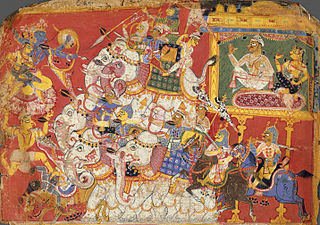
Naraka, also known as Narakāsura, and Bhaumāsura was an asura king, the legendary progenitor of all three dynasties of Pragjyotisha-Kamarupa, and the founding ruler of the legendary Bhauma dynasty of Pragjyotisha. Though the myths about Naraka are first mentioned in the Mahabharata, later texts embellish them. According to later post-Vedic texts such as the Brahma Purana and Vishnu Purana, he was the son of Bhudevi, fathered either by the Varaha incarnation of Vishnu. He is claimed as one who established Pragjyotisha. He was slain by Krishna and Satyabhama. His son Bhagadatta—of Mahabharata fame—succeeded him.
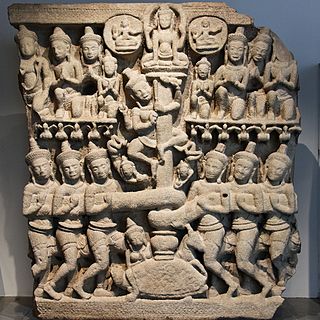
Hindu mythological wars are the wars described in the Hindu texts of ancient India. These wars depicted both mortals of great prowess as well as deities and supernatural beings, often wielding supernatural weapons of great power. Hindu teachings prescribe war as the final option, to be employed only after all peaceful methods are exhausted. Participation in righteous war, or dharmayuddha, was said to be honourable and was a principal duty of the Kshatriya or the warrior varna, and victory in such wars was regarded as a matter of honour.

Satyabhama, also known as Satrajiti, is a Hindu goddess and the third queen consort of the Hindu god Krishna. Satyabhama is described as an incarnation of Bhumi, an aspect of Lakshmi. She is the goddess and the personification of the Earth. She has two sisters named Vratini and Prasvapini who are her co-wives as well. According to some traditions, she is regarded to have aided Krishna in defeating the asura Narakasura.

A shaligram, or shaligrama shila, is a fossilized stone or ammonite collected from the riverbed or banks of the Kali Gandaki, a tributary of the Gandaki River in Nepal. It is also considered a form of Vishnu within Hinduism. The Kali Gandaki river flows through sacred places such as Muktinath and Damodar Kunda, enhancing the spiritual significance of these shaligrams.
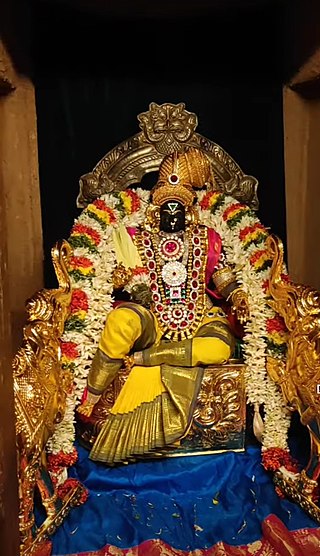
Bhumi, also known as Bhudevi, Dharani, and Vasundhara is a significant goddess in Hinduism, personifying the Earth. Her earliest form is reflected in the Vedic goddess Prithvi, though their roles and depictions are drastically different.
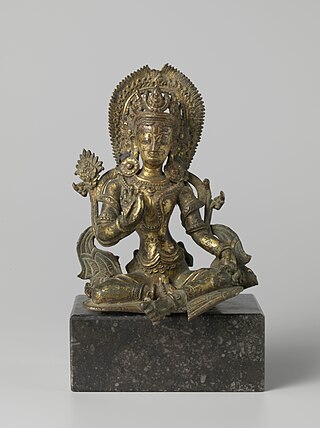
Indrani, also known as Shachi, is the queen of the devas in Hinduism. Described as tantalisingly beautiful, proud and kind, she is the daughter of the asura Puloman and the consort of the king of the devas, Indra.

In Hindu mythology, the danavas are a race descending from Kashyapa and his wife Danu, a daughter of the progenitor god, Daksha. It is mentioned that there are one hundred danavas.
Vishnu Puran is an Indian television series, by B. R. Chopra on the Hindu deity Vishnu. It is based on the Bhagavata Purana. Bhagavata Purana tells about the 10 incarnations of Vishnu, as well as other stories, such as the legend of Dhruva. The weekly series first aired Sunday morning, 23 January 2000 on Zee TV. The 124 episodes were later released on DD National.

Prahlada is an asura king in Hindu mythology. He is known for his staunch devotion to the preserver deity, Vishnu. He appears in the narrative of Narasimha, the lion avatara of Vishnu, who rescues Prahlada by disimboweling and killing his evil father, the asura king Hiranyakashipu.
Tarakasura is a powerful asura in Hindu mythology. He is the son of the asura Vajranga and his wife Vajrangi. Taraka had three sons: Tarakaksha, Vidyunmali, and Kamalaksha, who were known as the Tripurasura. He is slain by Kartikeya.

In Indian religions, Patala, denotes the subterranean realms of the universe – which are located under the earthly dimension. Patala is often translated as underworld or netherworld. Patala is described as more beautiful than Svarga. Patala is described as filled with splendid jewels, beautiful groves and lakes.
Besides the Ashtabharya, Krishna is described to have married several thousand women, he rescued from the demon Narakasura. The Bhagavata Purana and the Mahabharata state that 16,000 women were rescued, however the Vishnu Purana and the Harivamsa differ and set the number as 16,100. Generally all of them are unnamed, however many commentators of the Bhagavata Purana regard Rohini to be their leader, though such an explicit mention is not found in the scripture.

Kalanemi is an asura in Hindu mythology. He is the son of Virochana, and the grandson of Prahlada. He is slain by Vishnu in the Tarakamaya War, in which he is described to be a commander. In one of his rebirths, in various traditions, he is born as Kamsa, the son of Ugrasena, and becomes the king of Mathura. His nephew, Krishna, an avatar of Vishnu, slays him for his tyranny. Kalanemi's daughter, Vrinda, becomes Jalandhara's wife.

Narasimha Jayanti is a Hindu festival that is celebrated on the fourteenth day of the Hindu month of Vaisakha (April-May). Hindus regard this as the day the deity Vishnu assumed his fourth avatar in the form of a "man-lion", known as Narasimha, to vanquish the oppressive asura king Hiranyakashipu and protect his devotee Prahlada. The legend of Narasimha represents the victory of knowledge over ignorance and the protection offered by God to his devotees.
















